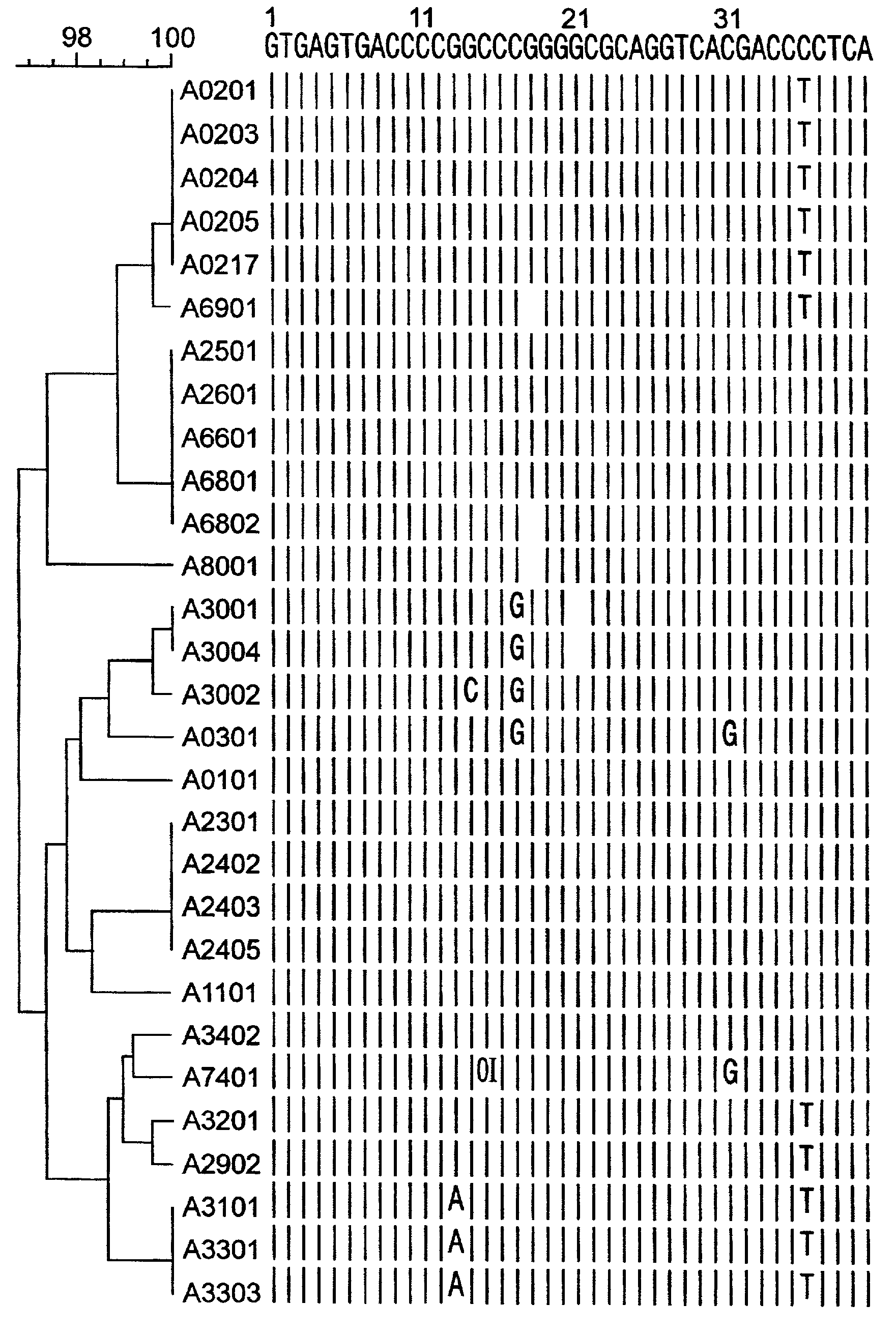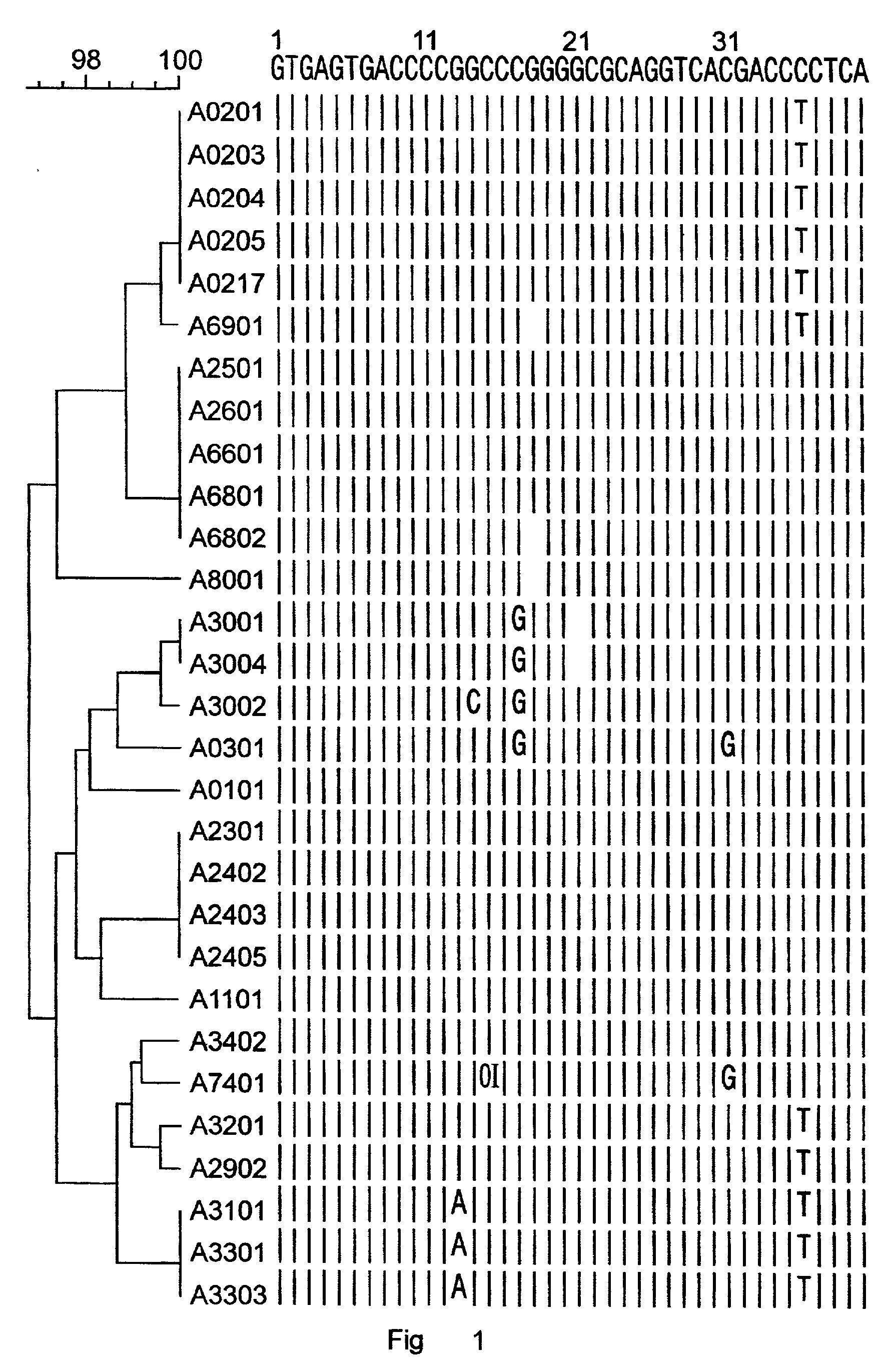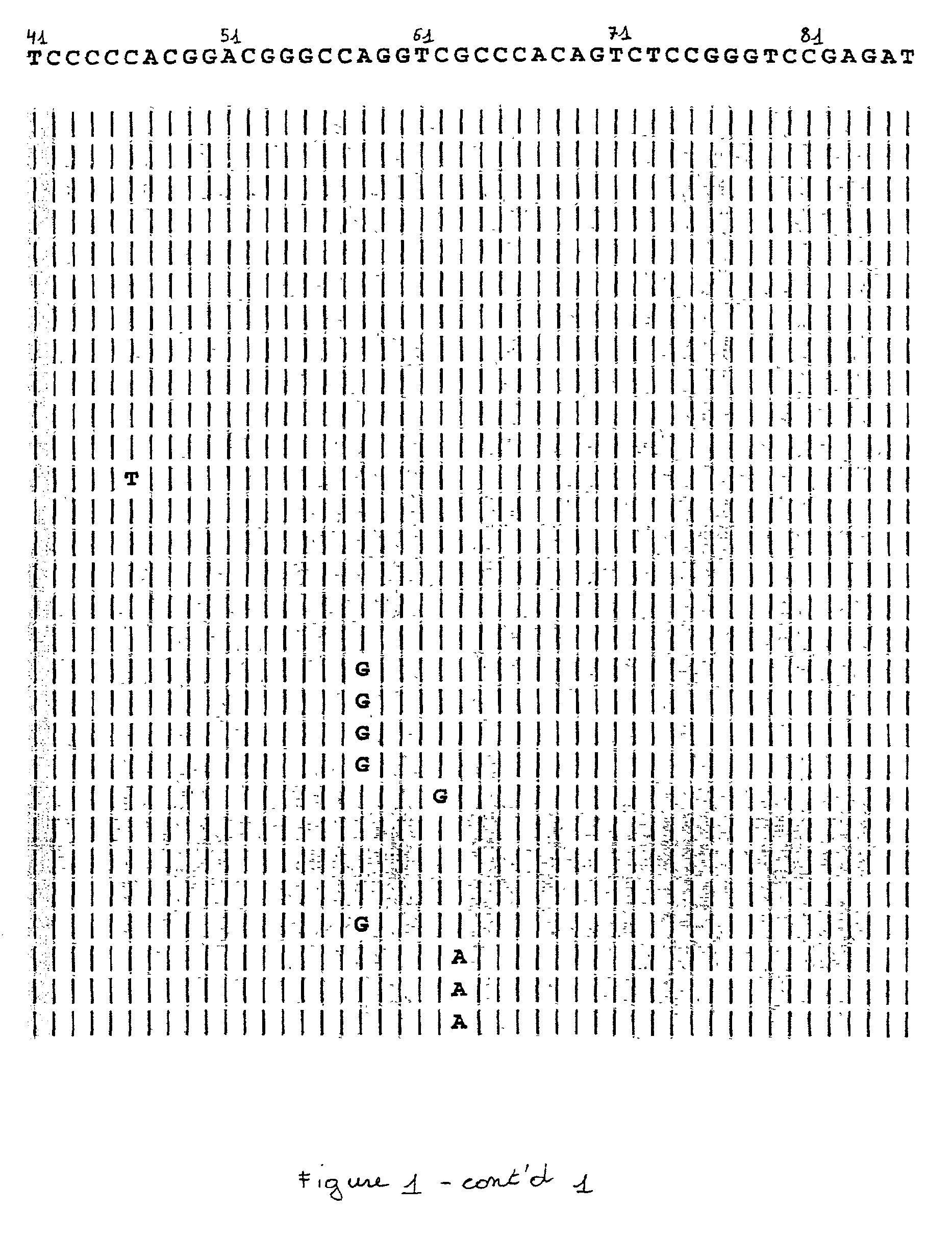Method for the amplification of HLA class I alleles
a technology of alleles and amplification methods, applied in the field of amplification of hla class i alleles, can solve the problems of inefficient hybridization of some probes, go undetected, and provoke allograft rejection
- Summary
- Abstract
- Description
- Claims
- Application Information
AI Technical Summary
Benefits of technology
Problems solved by technology
Method used
Image
Examples
example 1
Sequence determination of intron 2 of various HLA-A, HLA-B and HLA-C alleles
[0176] Nucleic acids were prepared from different blood samples by use of the QIAamp Blood Kit (Qiagen, Hilden, Germany) according to the manufacturer's protocol. Part of exon 1, intron 2, exon 2, intron 2 and exon 3 of HLA-A were amplified by use of the following primer set:
27 SEQ Primer Sequence (5'-3') ID NO 5APBio (5') B-TTCTCCCCAGACGCCGAGGATGGCC 144 3APBio (3') B-CCGTGCGCTGCAGCGTCTCCTTCCCG 147 B = biotine.
[0177] Exon 2, intron 2 and exon 3 of HLA-B were amplified by use of the following primer set:
28 SEQ Primer Sequence (5'-3') ID NO IBPin1 (5') B-GGGAGGAGCGAGGGGACCSCAG 145 IBPin3 (3') B-GGAGGCCATCCCCGGCGACCTAT 148 B = biotine.
[0178] Exon 2, intron 2 and exon 3 of HLA-C were amplified by use of the following primer set:
29 SEQ Primer Sequence (5'-3') ID NO 5CIN1 (5') B-AGCGAGGGGCCCGCCCGGCGA 146 3CIN3 (3') B-GGAGATGGGGAAGGCTCCCCACT 149 B = biotine.
[0179] The PCR reaction cycle was composed of the followin...
example 2
Amplification of exon 2 and exon 3 of HLA-A
[0188] Nucleic acids were prepared from different blood samples by use of the QIAamp Blood Kit (Qiagen, Hilden, Germany) according to the manufacturer's protocol. Based on the sequence alignment of the HLA-A intron 2 sequences (FIG. 1), a reverse and a forward, locus-specific primer was designed for the specific amplification of the HLA-A exon 2 and exon 3, respectively. With these primers, a primer mix was constructed for the separate amplification of exon 2 and exon 3 of HLA-A consisting of the following 2 primer sets:
[0189] for exon 2: 5APBio (SEQ ID NO 144) as forward primer and 5'ATCTCGGACCCGGAGACTGT3' (SEQ ID NO 1) as reverse primer;
[0190] for exon 3: 5.degree. CAGTTTAGGCCAAAAATCCCCC3' (SEQ ID NO 104) as forward primer and 3APBio (SEQ ID NO 147) as reverse primer.
[0191] The PCR reaction cycle was composed of the following steps:
[0192] 5 min at 96.degree. C.;
[0193] 35 times (30 s at 96.degree. C.; 20 s at 58.degree. C.; 30 s at 72.degr...
example 3
Amplification of exon 2 and exon 3 of HLA-B
[0196] Nucleic acids were prepared from different blood samples by use of the QIAamp Blood Kit (Qiagen, Hilden, Germany) according to the manufacturer's protocol. Based on the sequence alignment of the HLA-B intron 2 sequences (FIG. 2), a reverse and a forward, locus-specific primer was designed for the specific amplification of the HLA-B exon 2 and exon 3, respectively. With these primers, a primer mix was constructed for the separate amplification of exon 2 and exon 3 of HLA-B consisting of the following 2 primer sets:
[0197] for exon 2: IBPin1 (SEQ ID NO 145) as forward primer and 5'ACCCGCGGGGATTITGGCCTC3' (SEQ ID NO 310) as reverse primer;
[0198] for exon 3: 5'ACCCGGTTTCATTTTCAGTTG3' (SEQ ID NO 121) as forward primer and IBPin3 (SEQ ID NO 148) as reverse primer.
[0199] The PCR reaction cycle was composed of the following steps:
[0200] 5 min at 96.degree. C.;
[0201] 35 times (30 s at 96.degree. C.; 20 s at 58.degree. C.; 30 s at 72.degree. C....
PUM
| Property | Measurement | Unit |
|---|---|---|
| Angle | aaaaa | aaaaa |
Abstract
Description
Claims
Application Information
 Login to View More
Login to View More - R&D
- Intellectual Property
- Life Sciences
- Materials
- Tech Scout
- Unparalleled Data Quality
- Higher Quality Content
- 60% Fewer Hallucinations
Browse by: Latest US Patents, China's latest patents, Technical Efficacy Thesaurus, Application Domain, Technology Topic, Popular Technical Reports.
© 2025 PatSnap. All rights reserved.Legal|Privacy policy|Modern Slavery Act Transparency Statement|Sitemap|About US| Contact US: help@patsnap.com



